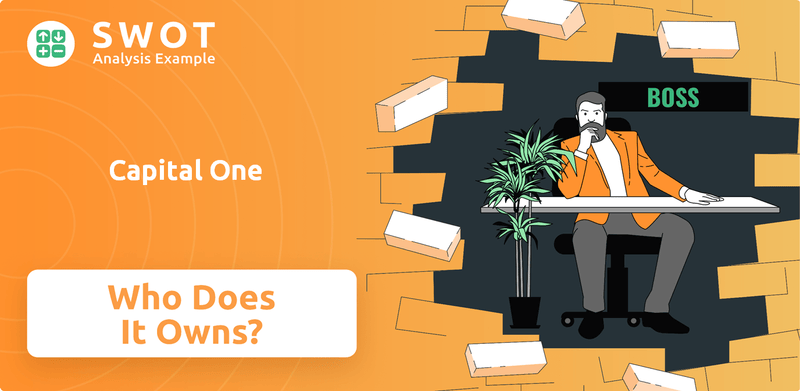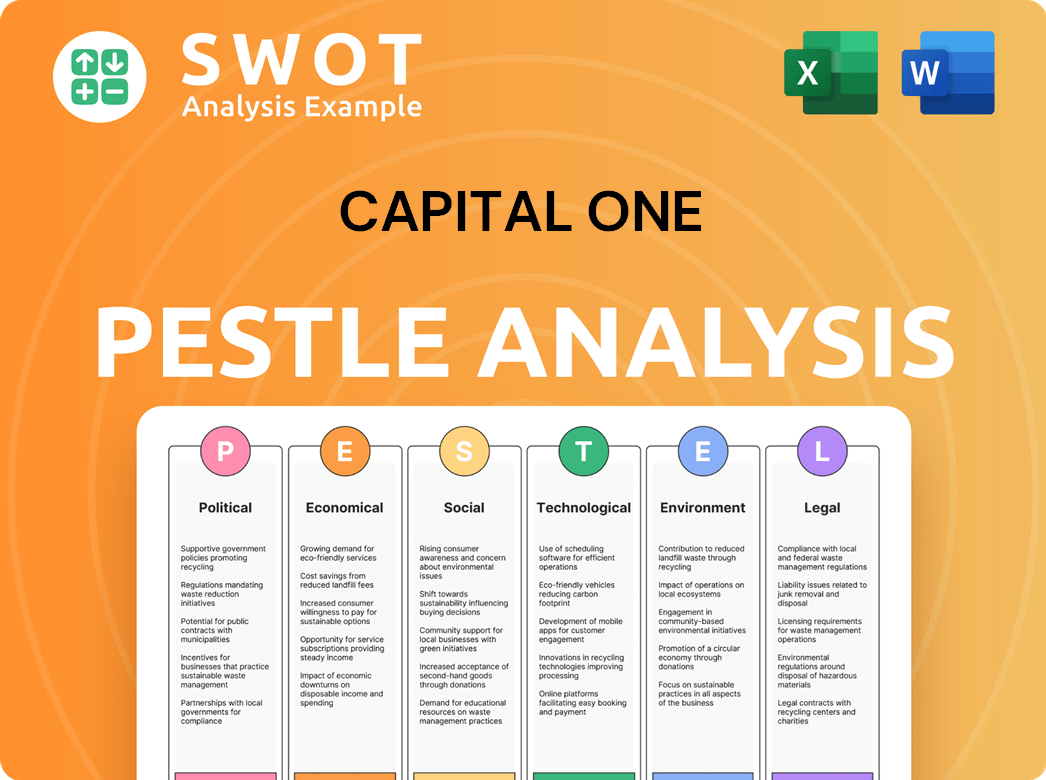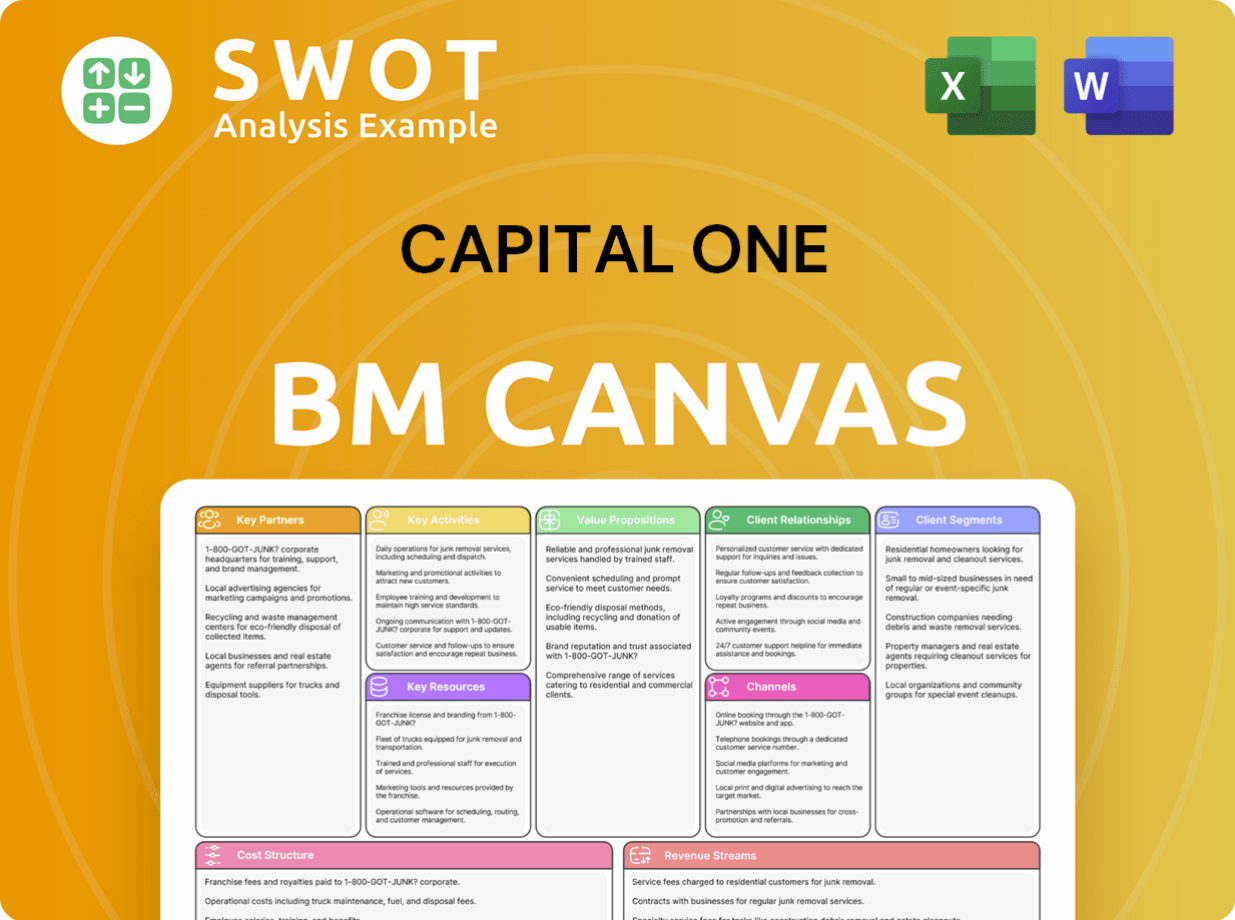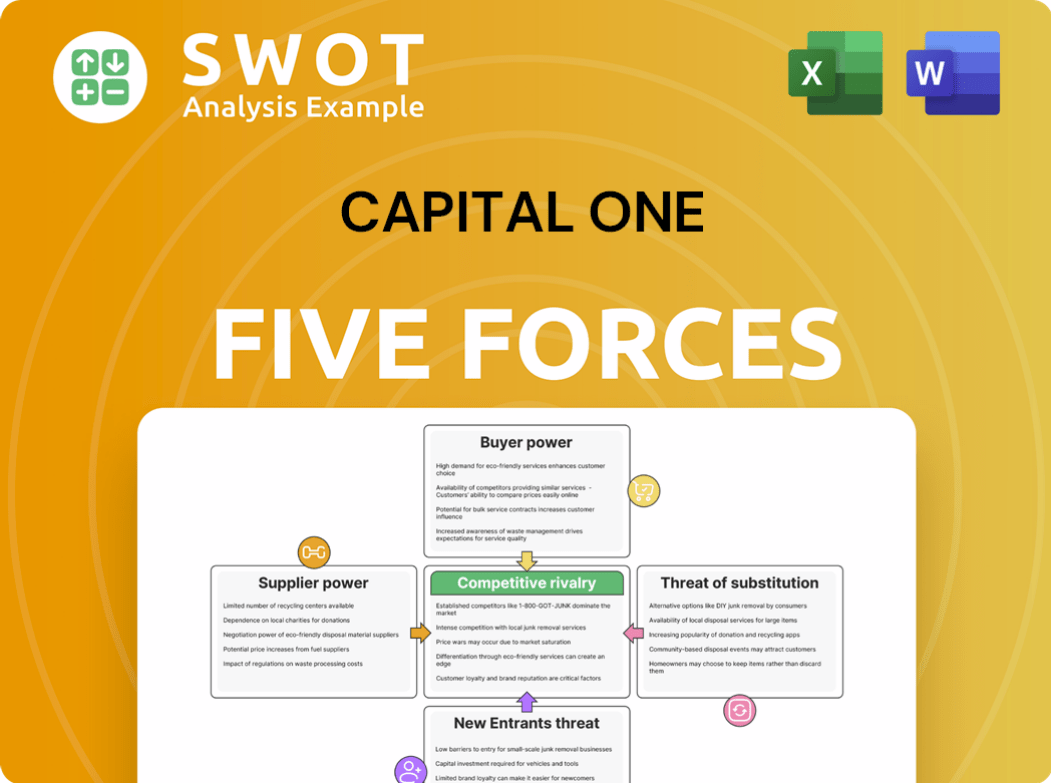Capital One Bundle
Who Really Owns Capital One?
Understanding the Capital One SWOT Analysis is crucial, but have you ever wondered who truly controls this financial powerhouse? The recent acquisition of Discover Financial Services for $35 billion reshaped the credit card landscape, making the question of Capital One's ownership more pertinent than ever. This article unveils the intricate ownership structure of Capital One, a company that has significantly impacted the financial industry.

Delving into the Capital One ownership structure reveals a fascinating interplay of founders, institutional investors, and market dynamics. As a major player in the financial sector, knowing who owns Capital One is key to understanding its strategic decisions and future trajectory. This exploration will uncover the roles of Capital One executives, major shareholders, and the evolution of the Capital One company, providing a comprehensive view of its corporate landscape. The Capital One headquarters location in McLean, Virginia, is just one piece of the puzzle in understanding this complex financial institution.
Who Founded Capital One?
The story of Capital One begins with its founders, Richard Fairbank and Nigel Morris, who established the company in 1988. Initially, it operated as a credit card division within Signet Banking Corporation. Their innovative approach to credit card marketing and issuance, driven by data analysis, set the stage for the company's future success.
In July 1994, the credit card division was spun off and renamed Oakstone Financial Corporation, with Richard Fairbank as CEO and Nigel Morris as COO. This marked a pivotal moment, leading to an Initial Public Offering (IPO) in November 1994. The IPO allowed the company to separate completely from Signet Bank in February 1995, and it was then rebranded as Capital One Financial Corporation.
Capital One quickly evolved into a major player in the financial sector, primarily focused on credit cards. This monoline structure, where credit cards were the sole revenue source, was a defining characteristic of the company's early years. The company's success is a testament to the founders' vision and their data-driven strategies, which helped shape the company's growth from its inception.
Richard Fairbank, as the founder, Chairman, and CEO, remains a key figure in the company's ownership. He has played a central role in shaping the company's strategic direction and growth. His continued leadership has been instrumental in Capital One's evolution.
The IPO in November 1994 was a critical step in Capital One's history, enabling its independence. It allowed the company to raise capital and operate separately from Signet Banking Corporation. The IPO was a significant milestone in the company's journey.
While specific equity splits at the company's inception are not fully detailed, the IPO provided a clear path for the company's ownership structure. The IPO was a critical step in establishing the company's ownership. The IPO was a significant milestone in the company's journey.
Nigel Morris, as COO and later Vice Chairman, played a vital role in the company's early development. His contributions were essential to the company's strategic direction. His expertise helped shape the company's early growth.
The founders' emphasis on data-driven strategies was a key differentiator. This approach allowed Capital One to target specific customer segments. This strategy significantly influenced the company's early growth.
Capital One initially operated as a monoline bank, focusing solely on credit cards. This focused business model allowed the company to specialize. This specialization was a key factor in its early success.
Understanding Capital One ownership involves looking at the roles of its founders and key executives. Richard Fairbank, as the largest individual shareholder, held a 1.11% stake in June 2024, with approximately 4,232,003 shares. His net worth was estimated at least $742 million as of June 14, 2025, primarily from his Capital One holdings. Nigel Morris, who served as Vice Chairman, held approximately 109,370 shares as of November 13, 2003, valued at over $21 million as of June 14, 2025. This early ownership structure reflects the founders' commitment and influence on the company's trajectory. For more details, you can read a Brief History of Capital One.
- Richard Fairbank: Founder, Chairman, and CEO, remains the largest individual shareholder.
- Nigel Morris: Co-founder and former Vice Chairman, played a crucial role in the company's early strategic direction.
- Shareholding Details: Fairbank's significant shareholding underscores his continued influence.
- Early Strategies: The founders' vision for leveraging data and technology significantly influenced the company's early growth.
Capital One SWOT Analysis
- Complete SWOT Breakdown
- Fully Customizable
- Editable in Excel & Word
- Professional Formatting
- Investor-Ready Format

How Has Capital One’s Ownership Changed Over Time?
The ownership structure of the company, a publicly traded entity on the New York Stock Exchange (NYSE: COF), has evolved considerably since its initial public offering in November 1994. The ownership is now distributed among institutional investors, individual shareholders, and company insiders. As of May 2025, the majority of shares are held by institutional investors, with approximately 97.19% of the stock.
Key events have significantly altered the ownership structure of the company. Strategic acquisitions have played a crucial role in transforming the company from a credit card issuer to a diversified financial services firm. The acquisition of Hibernia National Bank in 2005 for $4.9 billion and North Fork Bank in 2006 for $13.2 billion are notable examples. These acquisitions reduced its reliance on the credit card business, allowing the company to expand its product offerings and market presence, which has influenced its overall strategy and governance.
| Shareholder | Approximate Percentage of Shares Held (May 2025) | Approximate Number of Shares Held (May 2025) |
|---|---|---|
| The Vanguard Group | Approximately 8.20% | 31,257,286 |
| BlackRock, Inc. | Approximately 7.37% | 28,102,666 |
| Dodge & Cox | Approximately 9.28% | 35,372,196 |
As of May 2025, institutional investors own between approximately 69.68% to 89.22% of the company's stock. Insiders hold approximately 1.31%, while public companies and individual investors own about 9.47% to 19.54%. The total shares outstanding are approximately 374.78 million. Richard Fairbank, the founder, Chairman, and CEO, remains the largest individual shareholder, with a 1.11% stake as of June 2024. The officers and directors collectively own 1.29% of the stock.
Institutional investors are the primary owners of the company, holding a dominant share of the stock. Key institutional shareholders include The Vanguard Group, BlackRock, Inc., and Dodge & Cox. The company's ownership structure has evolved significantly since its IPO in 1994.
- The Vanguard Group holds approximately 8.20% of the company's stock.
- BlackRock, Inc. holds approximately 7.37% of the company's stock.
- Richard Fairbank, the CEO, is the largest individual shareholder.
- Strategic acquisitions have diversified the company.
Capital One PESTLE Analysis
- Covers All 6 PESTLE Categories
- No Research Needed – Save Hours of Work
- Built by Experts, Trusted by Consultants
- Instant Download, Ready to Use
- 100% Editable, Fully Customizable

Who Sits on Capital One’s Board?
The Board of Directors at Capital One plays a critical role in the company's governance. The board includes a mix of representatives, including the founder, major shareholders, and independent members. Richard D. Fairbank serves as the founder, Chairman, and Chief Executive Officer, indicating his significant influence. As of May 18, 2025, the board expanded from 12 to 15 members following the acquisition of Discover Financial Services. This expansion included three new directors from Discover's former board: Thomas G. Maheras, Michael Shepherd, and Jennifer L. Wong. This reflects the integration of the two companies and potential shifts in decision-making.
The voting structure for Capital One is based on common stock, with shareholders typically having one-share-one-vote. Major institutional investors, such as The Vanguard Group, BlackRock, and Dodge & Cox, hold a substantial portion of the company's stock, giving them considerable voting power. In February 2025, shareholders overwhelmingly approved the acquisition of Discover, with over 99.8% of the shares voted in favor, representing 85.1% of the total outstanding shares. This demonstrates the significant influence of the collective shareholder base in major corporate decisions. Information about the Growth Strategy of Capital One can be found in its investor relations materials.
| Director | Title | Additional Information |
|---|---|---|
| Richard D. Fairbank | Chairman, CEO, and Founder | Significant influence due to founder status. |
| Thomas G. Maheras | Director | Former Discover board member. |
| Michael Shepherd | Director | Former interim CEO and President of Discover. |
The concentration of institutional ownership implies that these large investors can significantly influence the election of board members and other key proposals through their voting power. Details on Capital One stock ownership by directors and executive officers are available in the company's proxy statements. There have been no widely reported proxy battles or activist investor campaigns recently that have dramatically reshaped the company's decision-making. The Capital One company profile highlights the company's structure and leadership.
The board of directors at Capital One includes the founder, major shareholders, and independent members. Major institutional investors hold a significant portion of the company's stock. Shareholders have considerable voting power in key decisions.
- Richard D. Fairbank is the founder, Chairman, and CEO.
- The acquisition of Discover Financial Services expanded the board.
- Institutional investors influence elections and proposals.
- Shareholders approved the Discover acquisition with over 99.8% approval.
Capital One Business Model Canvas
- Complete 9-Block Business Model Canvas
- Effortlessly Communicate Your Business Strategy
- Investor-Ready BMC Format
- 100% Editable and Customizable
- Clear and Structured Layout

What Recent Changes Have Shaped Capital One’s Ownership Landscape?
Recent developments in Capital One ownership have been significantly influenced by the acquisition of Discover Financial Services. Announced in February 2024, the all-stock transaction, valued at $35.3 billion, was finalized on May 18, 2025. This strategic move allows Capital One to control Discover's payments network, aiming to compete more effectively with industry leaders. The acquisition was approved by shareholders of both companies on February 18, 2025, with over 99% of shares voting in favor and received regulatory approvals on April 18, 2025, from the Federal Reserve and the Office of the Comptroller of the Currency.
The merger is projected to generate substantial synergies. By 2027, Capital One expects to achieve expense synergies of $1.5 billion and network synergies of $1.2 billion. The company plans to transition some credit and debit card volume to the Discover network. The initial timeline for debit card conversions has been adjusted, with a delay of around six months from the original Q2 2025 target. Furthermore, the acquisition has led to the addition of three former Discover board members to Capital One's Board of Directors.
In terms of broader ownership trends, Capital One maintains strong institutional ownership. As of May 2025, institutional investors hold approximately 97.19% of the shares. Insiders have slightly increased their holdings from 1.10% to 1.11%. This high level of institutional ownership reflects a trend common in the financial sector, where large asset managers and funds hold substantial stakes in major corporations. The market capitalization of Capital One has been reported differently by various sources, with one source citing a market cap of $123.43 billion as of June 2025 and another reporting $76.83 billion as of June 12, 2025. The founder, Richard Fairbank, continues to hold a significant individual stake, but the majority of ownership is dispersed among institutional investors and public shareholders. For more insights, check out the Marketing Strategy of Capital One.
Capital One's ownership is primarily held by institutional investors, reflecting the structure of a mature, publicly traded company. The significant institutional ownership indicates strong confidence in the company's performance and strategic direction. Individual ownership is concentrated with the founder, Richard Fairbank, alongside public shareholders.
The market capitalization of Capital One has been reported at varying figures, such as $123.43 billion (June 2025) and $76.83 billion (June 12, 2025). These figures demonstrate the company's substantial value and investor interest. Fluctuations in market cap highlight the dynamic nature of the financial markets.
The acquisition of Discover Financial Services is a pivotal move, positioning Capital One to compete more effectively in the credit card industry. The integration is expected to yield significant expense and network synergies. This strategic expansion also influences the composition of Capital One's leadership.
The future of Capital One involves the successful integration of Discover and the realization of anticipated synergies. The company is focused on leveraging its expanded network and market position. There have been no public announcements regarding the succession of Richard Fairbank or potential privatization.
Capital One Porter's Five Forces Analysis
- Covers All 5 Competitive Forces in Detail
- Structured for Consultants, Students, and Founders
- 100% Editable in Microsoft Word & Excel
- Instant Digital Download – Use Immediately
- Compatible with Mac & PC – Fully Unlocked

Related Blogs
- What are Mission Vision & Core Values of Capital One Company?
- What is Competitive Landscape of Capital One Company?
- What is Growth Strategy and Future Prospects of Capital One Company?
- How Does Capital One Company Work?
- What is Sales and Marketing Strategy of Capital One Company?
- What is Brief History of Capital One Company?
- What is Customer Demographics and Target Market of Capital One Company?
Disclaimer
All information, articles, and product details provided on this website are for general informational and educational purposes only. We do not claim any ownership over, nor do we intend to infringe upon, any trademarks, copyrights, logos, brand names, or other intellectual property mentioned or depicted on this site. Such intellectual property remains the property of its respective owners, and any references here are made solely for identification or informational purposes, without implying any affiliation, endorsement, or partnership.
We make no representations or warranties, express or implied, regarding the accuracy, completeness, or suitability of any content or products presented. Nothing on this website should be construed as legal, tax, investment, financial, medical, or other professional advice. In addition, no part of this site—including articles or product references—constitutes a solicitation, recommendation, endorsement, advertisement, or offer to buy or sell any securities, franchises, or other financial instruments, particularly in jurisdictions where such activity would be unlawful.
All content is of a general nature and may not address the specific circumstances of any individual or entity. It is not a substitute for professional advice or services. Any actions you take based on the information provided here are strictly at your own risk. You accept full responsibility for any decisions or outcomes arising from your use of this website and agree to release us from any liability in connection with your use of, or reliance upon, the content or products found herein.